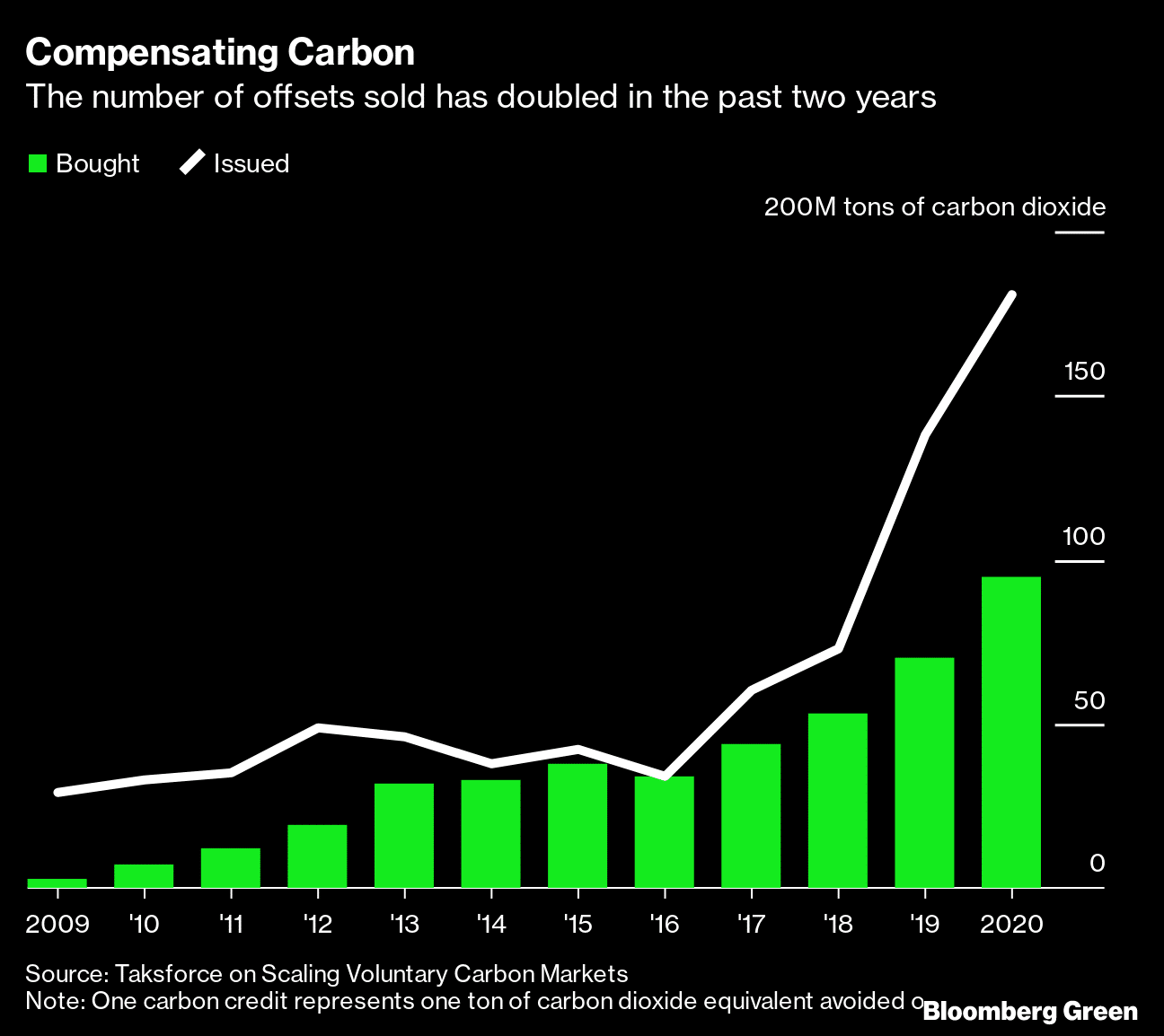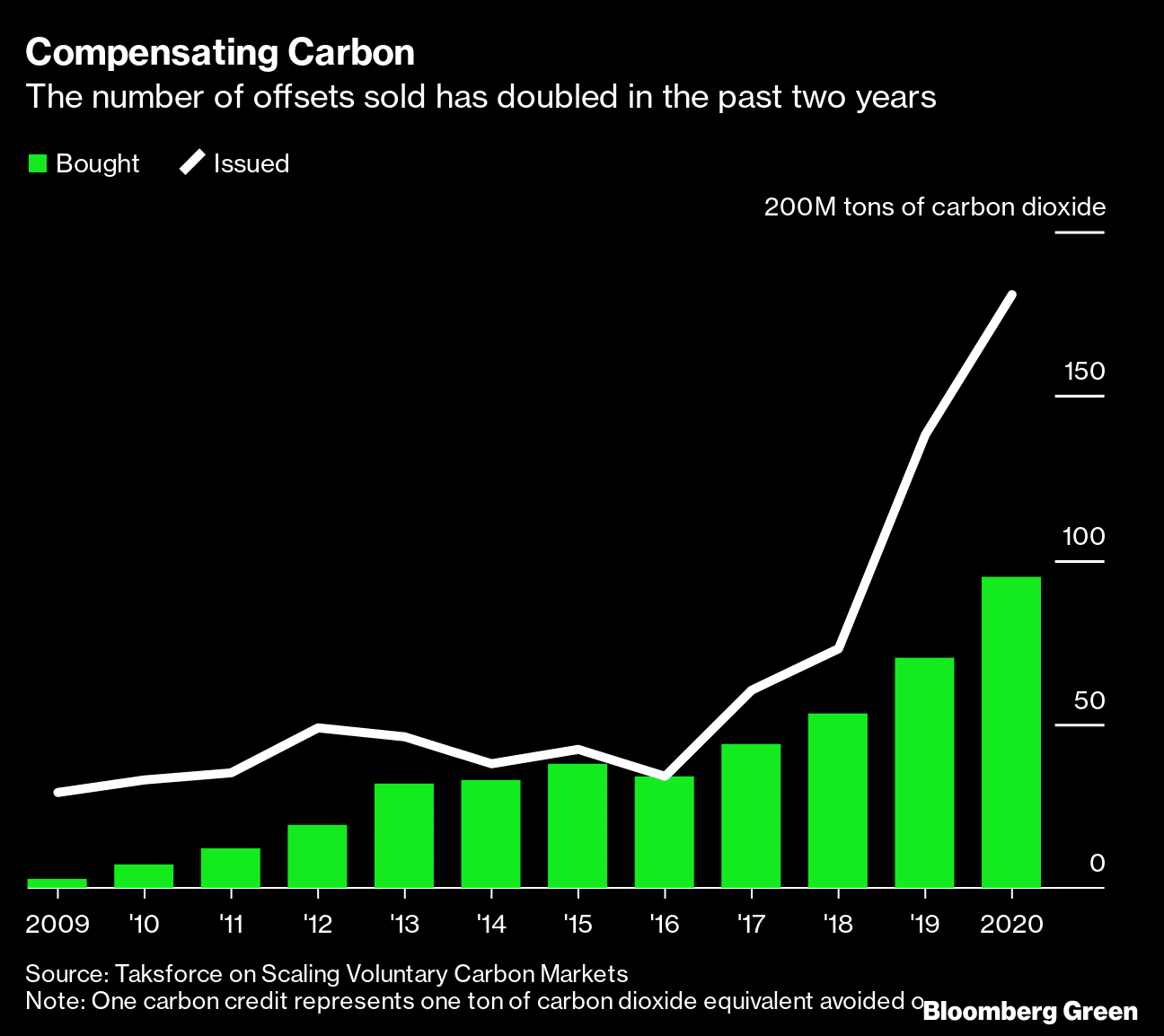“Ethical Markets highly recommends this additional important research on offsets by Akshat Rathi on Bloomberg Green’s tireless exposure of all the promises around the Paris Accords and IPCC’s call for net zero, echoed last week by none other than the International Energy Agency (IEA) www.iea.org on the need to stop all fossil fuel investing now.
~Hazel Henderson, Editor“
As net-zero commitments from companies ramp up, so does interest in carbon offsets. It’s often the cheapest way to claim credit for eliminating a ton of carbon dioxide, typically through a small fee to protect forests or fund renewable energy. The company buying the offset gets to erase emissions from its ledgers without spending far larger sums to clean up its business.
Such is the exuberance for carbon offsets that the consultancy McKinsey & Co. estimates a voluntary trading market like the one being organized by two financial heavyweights, Mark Carney and Standard Chartered CEO Bill Winters, could be worth as much as $50 billion in 2030, up from just $300 million in 2018. Carney, the former governor of the Bank of England, has put the figure as high as $100 billion by the end of the decade.
In an interview last month, Winters said that private-sector demand would be enormous. “People with money” know that offsets are “likely to have tremendous support,” he said.

That’s one reason why late last year Winters and Carney launched the Taskforce on Scaling Voluntary Carbon Markets. The 400-plus group of experts across industry, academia and finance are looking to produce guidance within the next few months that will shape the global market. But there are rifts within the closed-door taskforce, as my Bloomberg Green colleague Jess Shankleman and I reported today. In interviews with more than a dozen members, we found impasses over what counts as a credible offset and who can access the market. (Bloomberg Philanthropies has pledged funding for the initiative.)
The bullish projections for carbon offsets underscore the importance of a reformed and unified global market as a force bringing greater transparency and higher standards than exists today. But there are those within the ranks of experts who worry about the severe limitations of carbon-offset projects and want the taskforce to address the fundamental questions that have lingered for decades.
Time is running out. Winters and Carney hope to launch a pilot market to trade carbon offsets later this year. The expectation is for the new market to trade a benchmark contract that, with enough buyers and sellers, can improve price discovery for offsets. That’s how the currently opaque process by which companies purchase offsets can mature into something more like a recognized commodity.
Brent crude is one such benchmark contract, accounting for about 60% of all the world’s oil traded on any given day. That doesn’t mean that 60% of the world’s oil comes from the North Sea, the source of the oil used to create the Brent benchmark, only that most barrels of oil are close enough in quality to be measured against the Brent standard. West African crude tends to trade at anything from a few cents less than Brent to a $2 discount, depending on characteristics like sulfur content and viscosity.
There’s a lesson in this for the commodification of carbon offsets—and a thorny problem. For a contract to be a benchmark, it needs to be a significant share of the total market. The vast majority of the offsets sold today cost less than $5 for each ton of carbon dioxide removed from the atmosphere. In many cases, the price per ton can be as low as $2. Winters has said that low-cost offsets are unlikely to meet the high bar that the taskforce is looking to set. If the current market is dominated by offsets that are too cheap, it could take years before there’s enough high-quality offsets to support a benchmark contract akin to Brent crude.
It’s likewise unclear if there will be as many buyers as needed for enough liquidity in the market to achieve true price discovery. That’s because groups like the widely followed Science-Based Targets initiative, or SBTi, currently prohibit offsets for meeting short-term corporate climate goals. SBTi has said it may allow the use of offsets in the future for hard-to-cut emissions, such as those from air travel, but only when there aren’t promising technological alternatives. The issue of who can and can’t buy offsets, and for what purpose, remains a subject of intense debate within the taskforce.
Perhaps the biggest unsolved issue is the concern that carbon offsets won’t become as fungible a commodity as corn or copper. Trees that store away carbon dioxide for five years before being burned in a wildfire are providing a fundamentally different service than a ton of the gas buried deep underground for thousands of years. Climate change is a problem of cumulative amount of greenhouse gases in the atmosphere, and many experts argue that the longer a ton of CO? can be stored away, the more valuable it should be. That might make it hard to set a standardized price.
Even if the new market considered only offsets from trees, it might prove vulnerable. Several investigations over the past year have shown that the trade in forestry offsets can be easily gamed. “Those who have moved early to ask which offset credits are real, are the people who learn the hardest that very of them are real,” said Danny Cullenward, a lecturer at Stanford Law School with an expertise in carbon removal who isn’t involved in the taskforce. He said those involved in the market-process are at risk of “putting the people who have stood up these programs historically in charge of defining quality.”
The offset market, if it comes together, will be self-regulated. That’s key to the approach put together by Carney and Winters, and it’s even in the name: Taskforce on Scaling Voluntary Carbon Markets. Buyers and sellers are incentivized to trade numbers on ledgers, but how can the rules incentivize verification? Will all the offsets trading hands in the new market truly lower greenhouse-gas emissions? As one taskforce participant we spoke to put it: Either the taskforce recommends the creation of a global regulator, or it risks the same failure that has met previous attempts.
— With assistance from Jess Shankleman and Alex Longley
Akshat Rathi writes the Net Zero newsletter, which examines the world’s race to cut emissions through the lens of business, science, and technology. You can email him with feedback.
Here’s what else you need to know in Green
Biden Suspends Trump’s Oil Leases in Arctic Refuge
It’s a victory to environmentalists who have argued for decades against oil development in Alaska.
BOE’s Bailey Says Disorderly Green Shift Could Spark Inflation
The world’s effort to shift away from using fossil fuels could spark inflation if it’s done in a disorderly way, he said.
G-7 Set to Back Green Rival to China’s Belt and Road Program
It plans to launch a green alternative to China’s Belt and Road initiative at a summit next week.
The Company Starting to Break Down Fashion’s Waste Problem
A one-time paper pulp manufacturer has a process to recycle the polyester-cotton blends.



